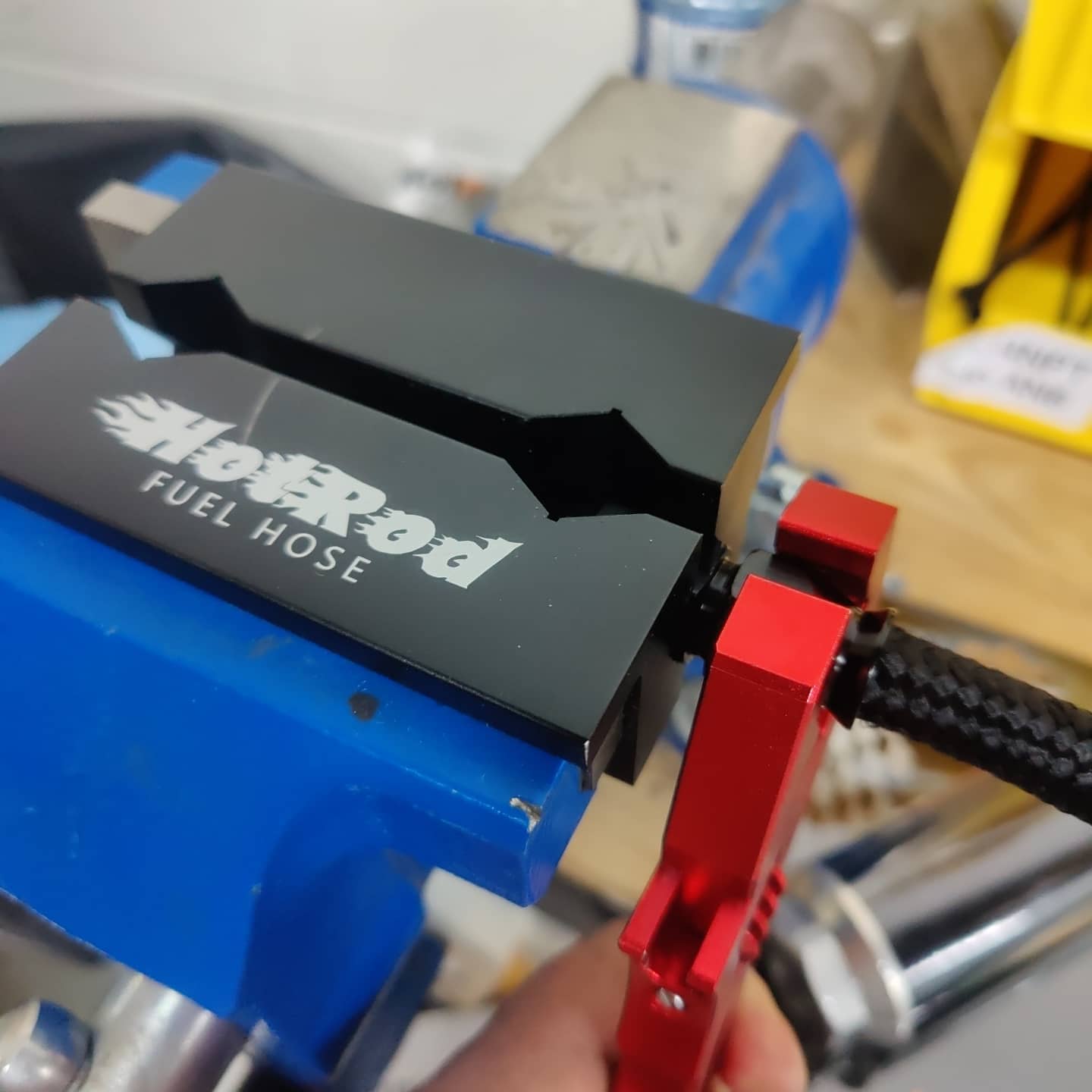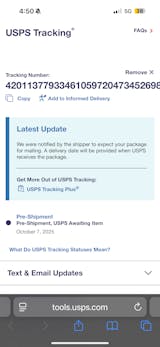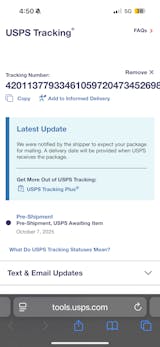How to Cut & Assemble PTFE AN Hose — Clean, Leak-Free, No Drama
AN Hose 101 • Hot Rod AN
Quick answer: Wrap the cut area with tape, cut with PTFE hose shears, install the olive (ferrule) on the PTFE liner, then assemble the hose end while holding the body in soft vice jaws and clocking the swivel. Pressure-test to finish.
Hose construction: Stainless braided = stainless-steel outer braid → PTFE core.
Nylon braided = nylon outer jacket → stainless-steel outer braid → PTFE core. Steps below apply to both styles.
Nylon braided = nylon outer jacket → stainless-steel outer braid → PTFE core. Steps below apply to both styles.
- Tools & parts checklist
- Plan the run (routing & marks)
- Cut PTFE braided hose (the clean way)
- Assemble the reusable PTFE hose end
- Pressure-test your new line
- Do & Don’t
- Common mistakes & quick fixes
- Parts & recommended products
- FAQ (click to expand)
Tools & parts checklist
| Item | What it’s for | Link |
|---|---|---|
| PTFE Hose Cutting Shears | Clean, square cuts through nylon jacket and stainless braid | Install Tools (Bundle) |
| Aluminum AN Wrench | Prevent marring on anodized fittings during final tighten | Install Tools (Bundle) |
| Soft Vice Jaws | Hold the hose end body securely without scratches | Install Tools (Bundle) |
| Tape (electrical or fiberglass) | Control jacket/braid fray at the cut location | — |
| Light oil / assembly lube | Lubricate threads & nipple during assembly | — |
| PTFE AN Hose & Reusable Hose Ends | The line and the fittings (with olive/ferrule) | PTFE Hose Bundles • PTFE Hose Ends |
Plan the run (routing & marks)
- Mock the path: Route away from exhaust and steering. Respect minimum bend radius.
- Leave service slack: Add a touch of length for engine movement and future service.
- Mark the cut: Place a tight tape band where you’ll cut; mark the exact center of the band.
Cut PTFE braided hose (the clean way)
- Tape it: Wrap the cut area tightly with 2–3 layers of tape (captures nylon jacket fuzz and stainless strands).
- Shear it: Use PTFE hose cutting shears to make a single, square cut through the jacket and braid. Avoid abrasive wheels that leave debris.
- Inspect: Peel back just enough tape to check the PTFE liner edge. If a tiny burr exists, lightly dress the liner (do not thin or flare it).
- Optional finish for nylon jacket: After assembly, slip a short heat-shrink collar over the jacket for a tidy look near the fitting nut.
Assemble the reusable PTFE hose end
- Slide on the nut: Put the hose end nut over the hose first (threads toward the cut end).
- Expose the liner: Use a small pick to gently push the stainless braid back just enough to reveal the PTFE liner.
- Install the olive (ferrule): Push the olive onto the PTFE liner until the liner seats fully against the olive’s internal shoulder. The stainless braid and nylon jacket stay outside the olive.
- Lubricate: Add a drop of light oil to the nipple and nut threads.
- Seat the nipple: Secure the hose end body in soft vice jaws. Insert the nipple into the hose/olive with steady pressure so you don’t push the olive back.
- Thread the nut: Hand-thread the nut onto the body without cross-threading. Hold the body and tighten with an aluminum AN wrench until fully seated. Clock the swivel to your angle as you tighten.
- Final check: Confirm the gap is closed, the olive is captured, and no braid strands are pinched.
Pressure-test your new line
- Cap & pressurize: Use an AN cap/plug on one end. On the other, apply regulated air (50–60 psi) or a hand pump with gauge.
- Bubble check: Submerge or mist with soapy water. No bubbles = good.
- Clean & dry: Depressurize, blow dry with clean air, and flush with the fuel you’ll run.
Do & Don’t
Do:
- Wrap before cutting; cut square with PTFE shears.
- Use aluminum AN wrenches and soft vice jaws.
- Lubricate threads and nipple; align clocking during assembly.
- Pressure-test every finished line.
Don’t:
- Don’t put sealant or tape on AN flare threads (seals at 37° flare face).
- Don’t cut with abrasive wheels that shed grit into the line.
- Don’t crush the braid under the olive or cross-thread the nut.
Common mistakes & quick fixes
| Problem | Why it happens | Fix |
|---|---|---|
| Frayed nylon jacket or stray stainless strands | No tape, dull blades, multi-cut motion | Wrap tighter; replace blades; make one clean cut; tidy with heat-shrink collar |
| Olive won’t seat | Braid blocking liner; cut not square | Trim flyaway strands; re-cut square; lightly dress liner edge |
| Leak at fitting | Cross-thread; olive displaced; under-tightened | Disassemble, inspect olive, re-lube, re-assemble, pressure-test |
| Scratched anodized nut | Steel wrench; no vice jaws | Use aluminum AN wrench & soft jaws |
Parts & recommended products
- PTFE Hose & Fittings Bundles — choose hose length/color and common angle combos.
- PTFE Hose End Fittings (all) — extra straights & angles for final clocking.
- Install Tool Bundle — PTFE shears, soft vice jaws, aluminum AN wrench.
- Clamps & Mounting Hardware — secure, serviceable installs.
FAQ (click to expand)
Do I need sealant on AN fittings?
No. AN fittings seal at the 37° flare faces. Sealant or tape is only for tapered pipe threads (NPT), not for AN flare threads.
Nylon vs stainless braided hose — what’s the difference?
Construction: Stainless braided = stainless-steel outer braid → PTFE core. Nylon braided = nylon outer jacket → stainless-steel outer braid → PTFE core. Nylon is friendlier to paint and touch; stainless is tougher near abrasion/heat. Same PTFE core, same assembly steps.
Can I reuse the olive (ferrule)?
Treat olives as single-use. If you disassemble after full seating, install a new olive for reliable sealing.
Why PTFE over rubber for fuel?
PTFE is ethanol-compatible with very low permeation, so lines don’t stink up the garage and stay stable with modern fuels.
Brake or power steering compatible?
No. Hot Rod AN PTFE hose here is for fuel and similar low-side fluids only.
Scope note: We do not offer AN-4. Exclude AN-4 in your parts planning.




0 comments